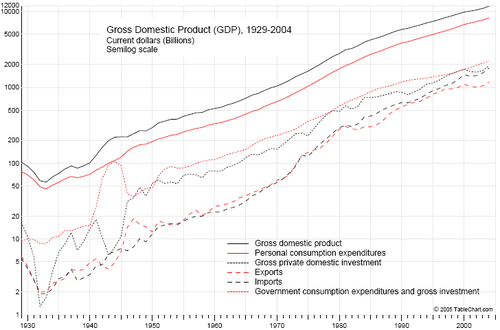User:Jers/blog/2011/11/27/What Fixed the Great Depression Really
What Fixed the Great Depression – Really?
27 November 2011 17:43:00 by J. E. R. Staddon
Our Greatest Generation president, FDR, drove unemployment down from 25% to 15% [!] during the ‘30s using this recipe [government spending on infrastructure, etc.]. Some make the point that WW2 ended the Great Depression…That’s true, but only because the war required the government to raise money to build the infrastructure for war...
(Frank Hyman, p 1A Raleigh News & Observer, December 2011)
This is a common view of the cause and cure of the Great Depression, but it needs a little unpacking. First, the reduction in unemployment from 25% to 15% during FDR’s tenure still leaves it at ludicrously high levels. If FDR prescribed a cure, it was only slightly better than the disease. WW2 did the job, though.
displays full blog post -- intended for inclusion with blog post SMW data
| Parameter | Description | Type | Status | |||
|---|---|---|---|---|---|---|
| No parameters specified | ||||||
First, the reduction in unemployment from 25% to 15% during FDR’s tenure stills leaves it at ludicrously high levels. If FDR prescribed a cure, it was only slightly better than the disease. WW2 did the job, though, reducing unemployment drastically, from 14.2% in 1940 to 4.7% in 1942. But living standards declined during the war. Even though GDP rose, personal consumption fell (see graph). No new cars were made, few new houses and appliances, etc. – which just shows how misleading GDP can be as a measure of living standards. Government can, in a pinch, keep people employed, at least for a while. But it cannot make them richer.
In retrospect, it is pretty clear what happened to the economy in the US between the Great Crash 929 and 1950. From 1929 to 1941, increased government expenditure elevated GDP erratically (graph), but put little dent in stratospheric unemployment levels. As a cure for the depression, FDR’s policies were in fact a failure. But in 1942, when the US declared war and military production ramped up, unemployment fell to the low single digits. Many more people were employed, and those who were not employed were drafted into the armed forces. People had more money in their pockets. But they could not spend it because of wartime restrictions – forced savings and a lack of consumer goods, for example. Their standard of living in fact fell (graph). After the war, many feared a return of unemployment, but the pent up demand from three years of austerity and the plentiful savings accumulated during that time, fueled a consumer boom that maintained industrial production (though now for consumer goods rather than war materiel) and maintained employment high for several decades.
Where did the money for wartime full employment come from? From taxes, yes, but mostly from government debt which, after the war, showed up as a devaluation of the currency. A measure of this devaluation is the price of gold. By government decree, gold was unavailable to individual American citizens from 1933 until 1971. Before the depression, gold sold for around $20/oz. After people were once again allowed to buy it, the price soon rose to hundreds of dollars per ounce. The loss of value of the dollar from 1928 to 1971 represents the debt incurred by the Federal Government during the Roosevelt years.
Presumably the present depression could be fixed in the same way as the Depression was fixed by WW2. But the Paul Krugman/Maynard Keynes solution – massive debt-funded government spending – is only half the story. The other half is to create enduring demand after the burst of spending by enforcing, as WW2 enforced, several years of austerity to go along with the government spending spree. Without the period of austerity, unemployment will likely increase and the depression return after the spending spree comes to an end. This may be happening in now. Somehow, I don’t think that several years of artificially enforced hard times would be regarded as an acceptable solution to our current problems.
- Note: the When Posted of this post was set to the date of the newspaper article on which it comments, since I don't know when the post was actually written.
- Original: Google Docs
Our Greatest Generation presid … <blockquote>Our Greatest Generation president, FDR, drove unemployment down from 25% to 15% [!] during the ‘30s using this recipe [government spending on infrastructure, etc.]. Some make the point that WW2 ended the Great Depression…That’s true, but only because the war required the government to raise money to build the infrastructure for war...</blockquote> (Frank Hyman, p 1A Raleigh News & Observer, December 2011)This is a common view of the cause and cure of the Great Depression, but it needs a little unpacking. First, the reduction in unemployment from 25% to 15% during FDR’s tenure still leaves it at ludicrously high levels. If FDR prescribed a cure, it was only slightly better than the disease. WW2 did the job, though.han the disease. WW2 did the job, though. +
